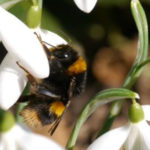Winter Active Bumblebees
Winter Active Bumblebees

For the most part only the Queen Bumblebee will hibernate over the winter. She will fatten herself up during the late Summer and Autumn, and then settle down for months of hibernation. By then the Queen will have been mated by the Males, who having done their work, will die, including the Worker Bumblebees, towards the end of the Summer. Having suitable undisturbed nest sites for the beautiful Queen is vital to get her through the Winter. She can spend nearly half her life in hibernation
Buff-tailed Bumblebees, Bombus terrestris, are one of the most common and wide-spread Bumblebees in the UK, and the Queen is one of the first species to emerge from hibernation in February. For these Bumblebees, however, Winter can be just as busy as the rest of the year. Due to climate change and milder Winters, especially in the South of England, Queens have been discovered making a nest in late Summer and Autumn (a nest lasts 3-4 months). A nest will exist through the Winter with Workers collecting nectar and pollen to sustain the nest, even in freezing conditions. Male Bumblebees can be found emerging in February. Sometimes a new Queen will emerge from these Winter nests. They will either set up their own nest, or go into hibernation. In either case, it is vital that they find food in a flowering plant before they can continue. The close proximity of these important Winter-flowering plants are why active Winter nests are found in suburban gardens in the southern part of England or Wales. There are very few wild British plants suitable for the short-tongued Buff-tailed that flower in the Winter
Gardeners can help these delightful bees by planting Winter flowering plants, like Mahonia,
Winter flowering honeysuckle and heathers and the resilient Salvia x jamensis (Hot Lips). The Bumblebee Conservation Trust gives further recommendations
Any sightings of Bumblebees active during the Winter can be reported to the Bees, Wasps and Ants Recording Society
Harriet English